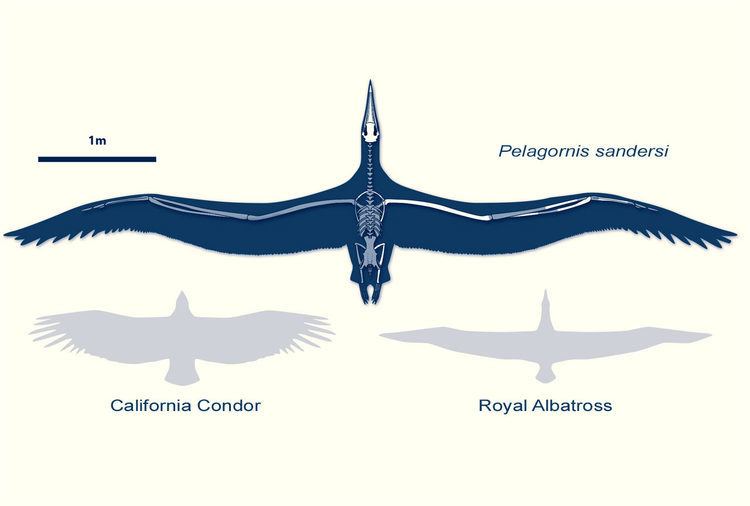Higher classification Pelagornis | Scientific name Pelagornis sandersi Rank Species | |
 | ||
Similar Pelagornis, Bird, Pelagornithidae, Dinosaur, Magnificent silver bird | ||
Pelagornis sandersi is a species of extinct flying bird with a wingspan estimated to be between 6.1 and 7.4 m (20 and 24 ft). If the larger estimated wingspan holds true, this makes it the largest flying bird yet discovered, with a wingspan twice as large as the living flying bird with the largest wingspan, the wandering albatross.
Contents

In this regard, it supplants the former largest known flying bird, Argentavis magnificens (which is also extinct). A. magnificens' wingspan, without feathers, was about 4.0 m (13.1 ft), while that of P. sandersi was about 1.2 m (4 ft) longer. P. sandersi's fossil remains date from 25 million years ago, during the Chattian age of the Oligocene.

Some scientists expressed surprise at the idea that this species could fly at all, given that, at between 22 and 40 kg (48 and 88 lb), it would be considered too heavy by the predominant theory of the mechanism by which birds fly. Dan Ksepka of the National Evolutionary Synthesis Center in Durham, North Carolina, who discovered the new species, thinks it was able to fly in part because of its relatively small body and long wings, and because it, like the albatross, spent much of its time over the ocean, where the bird relied on wind currents rising up from the ocean to keep it aloft.

Discovery

The only known fossil of P. sandersi was first uncovered in 1983 at Charleston International Airport, South Carolina, when construction workers were building a new terminal there. At the time the bird lived, 25 million years ago, this area was an ocean. The bird is named after Albert Sanders, the former curator of natural history at Charleston Museum, who led the excavation. It currently sits at the Charleston Museum, where it was identified as a new species by Dan Ksepka in 2014. "Though no feathers survived, Ksepka extrapolated the mass, wingspan and wing shape from the fossilised bones and fed them into a computer to estimate how the bird might fly. A conservative estimate put the wingspan of P. sandersi at around 6.4 metres."
Physiology

P. sandersi had short, stumpy legs, and was probably able to fly only by hopping off cliff edges. It has been estimated that it was able to fly at up to 60 km/h (37 mph). Like all members of the Pelagornithidae, P. sandersi had tooth-like or knob-like extensions of the bill's margin, called "pseudo-teeth," which would have enabled the living animal to better grip and grasp slippery prey. According to Ksepka, P. sandersi's teeth "don’t have enamel, they don’t grow in sockets, and they aren’t lost and replaced throughout the creature’s life span."
Comparison to pterosaurs
While P. sandersi's wingspan of 6.1–7.4 m (20–24 ft) is believed to be the largest known among birds, it is still far from the largest known flying animal. Flying pterosaurs such as Hatzegopteryx and Quetzalcoatlus are believed to have reached wingspans of up to 10–11 m (33–36 ft).
